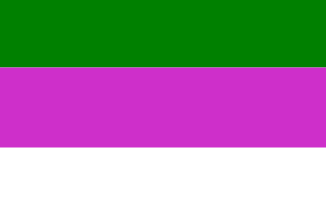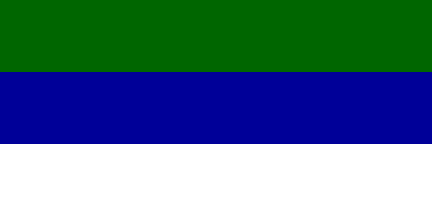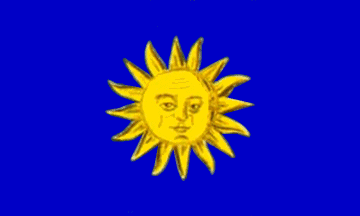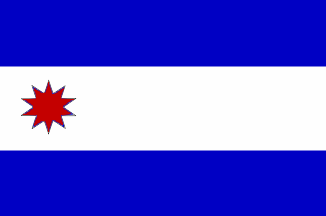
image by Maikel Arista-Salado, 26 May 2005

Last modified: 2007-06-23 by dov gutterman
Keywords: cuba | havana | la habana | museum |
Links: FOTW homepage |
search |
disclaimer and copyright |
write us |
mirrors
See also:
I found at <www.autentico.org> some 7 historical flags entitled:
1. Flag used by Juaquín Infante, 1810. (see: Joaquín Infante Flag (1810))
2. The flag flown during the conspiration of the
"Rayos" and "Soles" of Bolívar, 1823. (see:
Bolívar Flag (1823))
3. Club of the Havana flag, 1847. (see: "Club
de la Habana" Flag (1847))
4. Flag created by Narciso López on June 24, 1848 for the
conspiration of the Mina de la Rosa Cubana (Mine of the Cuban
Rose . (see: Conspiracy of La Mina de la
Rosa Cubana Flags (1848))
5. This flag was also used at the conspirtation of the Mina de la
Rosa Cubana on June 24, 1848. (see: Conspiracy
of La Mina de la Rosa Cubana Flags (1848))
6. Another flag used during the conspiration. (see: Conspiracy of La Mina de la Rosa Cubana Flags (1848))
7.Carlos Manuel Céspedes flag, raised on October 10, 1868. (see:
Céspedes Flag (1868))
Jarig Bakker, 21 December 1999 (translated by Juan
Manuel Gabino Villascán)
I've seen those flags before, in a book called "Banderas
oficiales y revolucionarias de Cuba" by Emilio Roig de
Leuchsenring edited back in 1950, in Havana by the Municipio
de la Habana.
Guillermo Aveledo, 21 December 1999

image by Maikel Arista-Salado, 26 May 2005
This flag was created by D. Joaquín Infante in his project of
Constitution in 1812. It was never adopted though.
Maikel Arista-Salado, 26 May 2005
Reported (Wrong?) Flags

image by Andy Weir, 11 January 2001
The other flag that claims to be Infante's is wrong. Correct
flags is above.
Maikel Arista-Salado, 7 February 2006
Ratio 2:3. Design of Bolívar for the union of Cuba - 1823.
Nickname: Sun's flag.
Jaume Ollé

image by Guillermo Aveledo, 6 October 2000
Flag used by the conspiracy of the "Suns and Rays of
Bolívar". Not led by the South American liberator, but
inspired and supported by him, 1823. This image is based on <www.autentico.org>
and the book "Banderas Oficiales y Revolucionarias de
Cuba", written by Emilio Roig de Leuschering, and published
in Havana, by the Municipio de la Habana publishing house, in
1950.
Guillermo Aveledo, 6 October 2000

image by Blas Delgado Ortiz, 29 April 2002
Pablo Acosta Ríos sent to Venezimbol the following
flag: It was the first flag of Cuban independence, a Freemason
society called "Suns and Rays of Bolívar", in 1823.
The Flag of Suns and Rays of Bolívar was the flag of a
conspiracy, led by the Liberator (the foreign policy of the
Republic was behind another thing in 1823, already being the
Republic of Colombia, with greater goals; the Antillean foreign
policy of Bolívar was active one decade previous). The
conspiracy, nevertheless, had the support and the inspiration of
Bolívar. It comes out very well described in the book
"Official and Revolutionary Flags Cuba" written by
Emilio Roig de Leuschering, and published by editions of the
Municipality of Havana, in 1950. This book is in the Central
Library of the UCV. A Venezuelan member of Venezimbol have the
impression (perhaps wrong, as he says) of having seen it like the
command flag, or personal standard, used by Bolívar during the
independence war.
Blas Delgado Ortiz, 29 April 2002
From <www.nacion.cult.cu>:
"The conspiracy Soles y Rayos de Bolívar adopted
its flag with deep blue center and in its medium point a shining
silver sun within a crimson circumference.
In the year 1823, under general Vives command, the francmasonic
lodge of the "Soles y Rayos de Bolívar", in
full accordance with other secret societies of the Island,
organized a conspiracy to overthrow the Spanish power and
founding the Republic of Cubanacán.
According to the summary instructed against the frustrated
conspiracy it is known that 395 red, yellow and blue badges were
found, together with “three silk flags of plain taffeta,
each one with two and a half yard long and one and a half width,
center deep blue and in its center a big sun with rays, as
enameled, silver colour and in its circumference a band crimson
colour”.
There are disagreement between the description and the design
found, because in it the sun is golden or yellow, and not silver
as indicated."
Miles Li, 21 October 2006

image by Guillermo Aveledo, 6 October 2000

image by Maikel Arista-Salado, 4 June 2005

image by Maikel Arista-Salado, 4 June 2005
The "Flag of the Mine Conspiracy of the Cuban Rose",
being the national flag until 1849 when the Venezuelan General
Narciso López created that very same year as his own flag which
is considered today an official symbol of the Republic of Cuba.
The flags are the same as the flag that was depicted on the Cuban
Coat of Arms printed on government correspondence and Provisional
Government bonds, together with the flag of the United States of
America.
Maikel Arista-Salado (translated by Esteban Rivera),
4 June 2005
Reported (Wrong?) Flags
1)
image by Guillermo Aveledo, 6 October 2000
2)
image by Guillermo Aveledo, 6 October 2000
3)
image by Guillermo Aveledo, 6 October 2000
Flags of the Conspiracy of La Mina de la Rosa Cubana, June
24th.
Guillermo Aveledo, 6 October 2000
See: Cuba - Céspedes Flag (1868)
Adopted: unnoficial use after 10 February 1878. Abolished: c.
1899.
Jaume Ollé
This image is based on a book of the editorial Agualarga
called BANDERA, HIMNO Y ESCUDO and is simply the spanish flag
ussed untill 1927 by the merchan marine crossed over.
J. C. Castillon, 3 May 2003

image by Maikel Arista-Salado, 26 May 2005
The autonomic flag, hoisted in 1895 in Baire, as you can see
is very similar to the spanish flag because of its meaning.
Maikel Arista-Salado, 26 May 2005
I guess that maybe the correct proportions of the horizontal
stripes of the flag could have been the ones of the Spanish Merchant Flag (1785-1927). So:
1+1+2+1+1. Because that historical Cuban flag could have been
made using a Spanish Merchant Flag with two diagonal stripes
added.
Francisco Gregoric, 29 May 2005
The autonomic flag was hoisted in 1895 in Baire, according to
D. Enrique Gay-Calbó in his magnificent book: "Los
símbolos de la nación cubana. los escudos, las banderas y los
himnos" (The symbols of the Cuban Nation. the coats of arms,
the flags and the anthems) in page 85.
The proportions of the flag are correct according to our
research; it was made for that specific day and it was a setup of
Gen. Rabí.
Maikel Arista-Salado, 30 May 2005

image by Ivan Sache, 5 May 2000
'Das Grossen Flaggenbuch' [gfb39] describes the 'flag of the 4th September 1933'. It is a 2:1 flag made of five equal vertical bands: blue, white, red, yellow and green. It was hoisted along with the National flag by the Army, the Navy and the Police. The 4th September 1933 is the end of the dictatorship of Machado.
Some questions about that:
1. Is this flag still in used ? Comparing 'Das Grossen Flaggenbuch' with 'Album des Pavillons', I noticed that several Cuban flags were not changed by Castro (including the national flag. The presidential flag just received two additional stars.)
2. What is the origin of the 4th September flag ? I suppose it
was inspired by the French tricolour, but the two additional
colours are not 'Cuban'.
Ivan Sache, 3 July 1997
In answer to your question, the answer is no. It is not
longuer ussed in Cuba since 1959. The "4 de septiembre
mouvement" was the movement started by the sargeants and
NCO's of the cuban army againts General Machado. This flag was
ussed in a semioficial way during the time of General Batista
influence.
Batista was a sargeant who toke command of the main garrison in
Cuba on 4 September. He was named "coronel" and became
head of the Army by the revolutionary center left government who
took power, became the strong man of the island, with the help of
the american Embassador and the army and againts both the
traditional elittes and the leftist students and elected the
"puppet" presidents before being elected himself
president from 1940 to 1944. Contrary to popular belief, in his
first times Batista was popular, made a series of structural
reforms, kind to the American New Deal, legalized the Communist
Party and allowed unions. In the 1940 elections, even Communist
Party backed him. In 1944 a Social Democratic Party, the
AUTENTICO party took power through elections and the 4 de
septiembre flag did dissapear form public functions untill 1952,
when Batista made a second "putsch" and get himself
back into power from 1952 to 1959.
The flag in question is supossed to represent all teh branches of
the Army, the police and, I think, la Guardia Rural, a sort of
police for the countryside.
J. C. Castillon, 3 May 2003
I would like to inform you that what is said about about
Batista overthrowing Machado is wrong. Machado resigned on August
12, 1933, yielding to the presion that Mr. Sumner Welles, the USA
president's envoy in Havana, and a group of offcial of the army
put on him. Machado left the country and went to live in Nassau.
A new goverment was set and Dr. Carlos M. de Cespedes was the
president. Then, 3 week later, a group of soldiers protest about
their pay and poor living conditiotions and with de support
of university students and some politician, that
protest become a revolucionary movement that overthrew Cepedes'
goverment.
That prostest srtarted under the leadership of Sargent Pablo
Rodríguez, but by the end of the day Sargent Fulgencio Batista
was the leader. It happened on 4th September 1933.
Eduardo Irueta, 26 April 2007
From: <www.cubaweb.cu>:
Museum of the City of Havana - The "Hall of Flags"
contains the original Cuban flag and the one flown by Carlos
Manuel de Cespedes when he began the first war for independence
in 1868, as well as a number of flags used by the Spanish
colonial government in Cuba.
Dov Gutterman, 18 June 2000